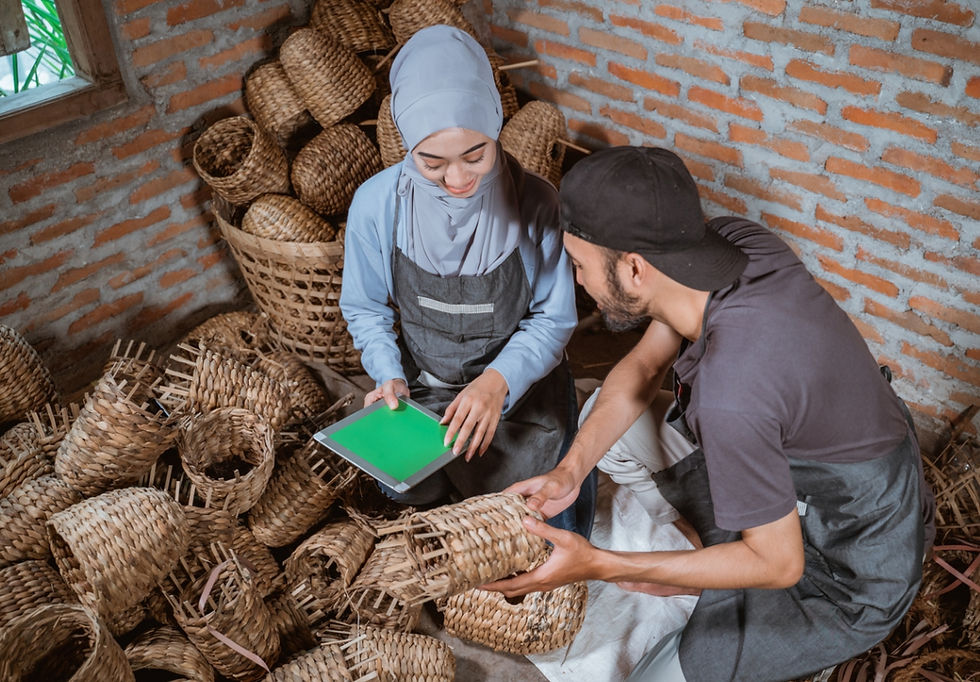From Culture to Commerce: India's Is On Its Way To Become A Sustainable Textile Powerhouse
- Bzaar Official Wix Account
- Feb 14, 2024
- 4 min read
Updated: Feb 15, 2024
The urgency to address climate change resonates across industries worldwide, from reducing carbon footprints to embracing circular economy principles. Representing approximately 20% of global greenhouse gas emissions, materials play a crucial role in the decarbonization agenda.
However, the shift towards sustainable materials is not just an ethical concern but a strategic imperative for business growth.

Sustainability is a key lever for business growth
McKinsey's analysis of five years of US sales data (2017-2022) underscores this reality, revealing a remarkable 28% cumulative growth for products with ESG-related claims, compared to 20% for those without such claims.
As Mckinsey rightly reports, “consumers care about sustainability and are backing it up with their wallets”.
Global policies are also looking to reward businesses with sustainable practices. The ‘EU strategy for sustainable and circular textiles’ wants to put ‘fast fashion out of fashion’.
In accordance with this by 2030 all textile products placed on the EU market have to be durable, repairable, and recyclable. They will, to a great extent, have to be made of recycled fibers, free of hazardous substances, and produced respecting social rights and the environment.
If you’re a business convinced to start its sustainability journey, your first concern is likely to be where to source sustainable raw materials?
With the global manufacturing migration steadily moving away from China and strongly towards India, the sub-continent also stands out as a natural choice for businesses seeking to align with sustainability values.
Find out why and remain ahead of the curve. 1. Sustainability ingrained in the Indian ethos A 2019 report by a global risk assessment and consulting firm listed India and China as one of the least wasteful countries compared to the United States which tops the list as the most wasteful one. India also shines through as a leader in recycling – it is the largest global recycler of PET products (recycling 90% of its waste) and of shipping units.
Despite being the world’s most populated country, how does India manage such commendable waste reduction and reuse? Mindful consumption is ingrained in the country’s culture.
India’s largest employers; agriculture and textile still predominantly use traditional methods of production – 95% of the world’s handmade textiles are made in India – making output significantly less wasteful.
Complementing the traditional production methods in the country is the Indian household. The family units in India are predominantly joint and large, making resources both shared and limited. The principles of circular economy then start at home and naturally penetrate into the average Indian’s way of life.
No wonder, Indians invented “jugaad” or the frugal innovation growth formula that disrupted corporate America. 2. A hot-bed for circular start-ups Riding on the back of a culture that instills sustainability, Forbes once described India as “a hotbed for circular startups” with the textile and apparel industry specifically re-inventing itself for sustainability.
India’s entrepreneurs have embraced the circular economy agenda, as they experiment with new-age sustainable materials from cork, hemp to banana fiber and cactus leather. Even the world’s only fashion fund that invests in green tech for sustainable textile production has made its bets in India. 3. Natural fiber dominance leveraged by market maturity India is the world’s largest producer of jute and organic cotton. Natural fibres are also considered the backbone of the Indian textiles industry which is projected to reach to $195 billion by 2025 from its current $138 billion in 2023.
Apart from having sustainable fibers readily available, India is also a design-ready market ready to scale its sustainable material production.
Common Objective reports that “over the last decade India’s production of environmentally sustainable textiles and apparel has boomed and not just in the knits, soft separates and casualwear for which it is known but also in high-quality wovens.”
“Ten years ago it was not possible to get high-end woven fabrics in organic cotton here [in India]...now you can get beautiful products without compromising aesthetics, performance, and durability,” says Sreeranga Rajan of Dibella India, that supplies Loomstate, Nudie and Knowledge Cotton Apparel amongst others.
Other global companies using India’s sustainable supply chains at scale include Patagonia, which produces all their organic yoga wear and hoodies from the organic and Fairtrade-certified Prathibha Syntex mill in Madhya Pradesh. While C&A made the world’s first C2C-certified jeans with Arvind Mills in Ahmedabad. 4. Evolved certification system leads sustainable textile standards India's certification ecosystem has rapidly evolved and is now closer to ensuring compliance with global standards.
The country offers the largest number (1,254) of Global Organic Textile Standard (GOTS) certified facilities compared to China (220). Further, there are 977, SA8000 certified units, compared with China’s 606 and Bangladesh’s 4. While 40% of global Fairtrade cotton-certified producers or traders belong to India.
Indian suppliers in organic cotton offer an authentic business proposition for sustainability-minded buyers.
An unprecedented global advantage

India's potential as a hub for sustainable materials is a multifaceted narrative shaped by macro-economic factors, geographic advantage, and a legacy of traditional production. Further bolstered by a mature market poised for scalability, propelled by entrepreneurs, and artisans. Such a distinctive blend of advantages and opportunities are unlikely to be found elsewhere in the world. Payal Mohta is a freelance content writer, editor, and strategist. She writes about everything business and tech.



Comments